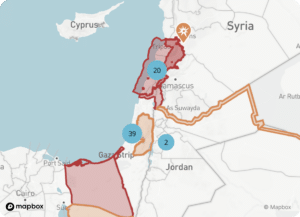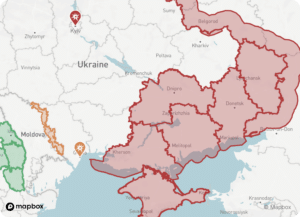Continued hostilities, especially with increased US backing for Israel under President-elect Donald Trump, are expected to worsen the humanitarian crises and drive large-scale displacements from the Palestinian Territories and Lebanon, straining an already fragile region.
Conflict between Ukraine and Russia
By late 2024, Russia has intensified military pressure in eastern Ukraine, slowly grinding down the defenders and seizing territory. At the same time, Russian forces have yet to dislodge Ukrainian troops from the districts they captured in a surprise offensive into Russia’s Kursk oblast. Russia aims to secure full control of the four Ukrainian oblasts it claimed to annex in 2022 before even considering entering into negotiations. Public fatigue in Ukraine has grown, with 57 percent now supporting negotiations, ahead of a potentially brutal winter due to Russian attacks on energy infrastructure over the summer. Western support is also slowing, as Germany reduces its aid commitments for austerity reasons and long-term United States (US) backing remains uncertain following the reelection of President Donald Trump, who has called for an end to US military aid and US withdrawal from the North Atlantic Treaty Organization (NATO). Despite European peace efforts, Russia’s current military advantage and Western reluctance to become more deeply involved will hinder any near-term resolutions.
Rising tensions in the Korean Peninsula
Tensions between North and South Korea are expected to intensify in 2025, increasing the likelihood of skirmishes along their borders and regional flight disruptions. In 2024, North Korea flew trash-laden balloons that disrupted flights in South Korea, cut all overland road and rail links and stepped up military cooperation with Russia. In response, South Korea has resumed propaganda operations and boosted military cooperation with the United States (US). De-escalation is unlikely, as both sides’ leadership can seek to consolidate their support bases, racking up regional tensions, as the current South Korean government of President Yoon Suk Yeol has seen record-low public approval in recent months and the North Korean regime considers the possibility of the ailing Kim Jong-un’s eventual succession.
Cyberwar and Cybercrime
Advancements in artificial intelligence (AI) are expected to substantially increase the frequency and impact of cyberattacks throughout 2025, reshaping modern warfare. Russia prefaced its 2022 invasion of Ukraine with crippling cyberattacks on Ukrainian military communications. And since 2023, Israel has made extensive use of AI-targeting in warfare and compromised electronic supply chains to stage audacious bomb attacks targeting Hezbollah. Cyberattacks offer militaries and non-state actors new means to destroy critical infrastructure and demoralise civilian populations. The intersection of state actors with ransomware extortionists continues to blur as well. Russia’s “hybrid war” in Europe has seen the remote recruitment of career criminals, paid in untraceable cryptocurrency, by Russian security services to plant bombs, set fires and distribute propaganda.
In mid-September 2024, a suspected Israeli malware attack on Hezbollah-affiliated communication devices caused numerous casualties in Lebanon and Syria.
AI-driven cyberattacks are projected to target both military and civilian assets, putting communication systems, transportation networks and critical infrastructure like banks and hospitals at elevated risk. Civilian flights and GPS systems in conflict zones face severe disruptions from jamming and denial of service attacks, while AI-powered disinformation campaigns are influencing elections worldwide, threatening democratic integrity.



